Serviços Personalizados
Journal
artigo
Indicadores
Compartilhar
Journal of Human Growth and Development
versão impressa ISSN 0104-1282
Rev. bras. crescimento desenvolv. hum. vol.24 no.1 São Paulo 2014
ORIGINAL RESEARCH
Safety against fire in basic health units
Amaury Machi JuniorI; André QuiaiosII; José Nuno DominguesII; Ana FerreiraII; Susana PaixãoII; Nelson Leite SáII; Ligia Ajaime AzzalisIII; Virginia Berlanga Campos JunqueiraIII; Odair Ramos da SilvaI; Maria Teresa Conceição VicenteII; Fernando Luiz Affonso FonsecaI, III
IEnvironmental Health Management - Faculdade de Medicina do ABC, Santo André, SP, Brasil
IIEnvironmental Health Degree - Escola Superior de Tecnologias da Saúde de Coimbra - Instituto Politécnico de Coimbra, Coimbra, Portugal
IIIDepartamento de Ciências Biológicas - Instituto de Ciências Ambientais, Químicas e Farmacêuticas - Universidade Federal de São Paulo, Diadema, SP, Brasil
ABSTRACT
Nowadays it is widely recognized the demand of a modernization of the Government and his administrative entities. According to the legislation referent to fire prevention the Firefighters were the most proactive entity concerning the creation of legislation based on the tragic incidents and the experience acquired in daily routines. A fire can occur in any situation whether exist or not human activities and Basic Health Units are not free from this event and unfortunately a real possibility of this happening due to elevated fire charge. The purpose of this study was to evaluate the level of knowledge and that employees have in relation to Fire Safety theme and confront the findings with the needs required by law due to the non-mandatory fire brigade constitution in Basic Health Units with ground floor and inferior to 750 m² whose requisites fulfill the vast majority of buildings. The research method is qualitative observational and descriptive by convenience sample in nine Basic Health Units in city council Santo André,(São Paulo, Brazil) with the aim to enrich the health professionals knowledge about fire prevention was also evaluated in this case study.
Key words: fire extinguishing systems, familiarity with fire extinguishing, basic health units, health professionals.
INTRODUCTION
Throughout world history there are many examples of huge proportions fires with serious economic and patrimonial consequences. Among these, the extensive fires of London and Chicago are unquestionably two of the most remarkable and resulted practically in a total destruction of both cities and the loss of an enormous number of human lives.
In Portugal the "Chiado" fire held in Lisbon in 1988 is arguably the most striking example. It had even supported the creation of the first Portuguese legislation dedicated to this theme, the "Decreto Lei. 426/89 de 6 de Dezembro - Medidas Cautelares de Segurança contra Risco de Incêndios em Centros Urbanos Antigos"1. Recently in Brazil the fire at nightclub Kiss in Santa Maria affected hundreds of victims. There was no definite place or date but the event was predictable2.
Basic Health Units play an important role in treating the population's health because they serve approximately 80 % of the population and perform the respective screening. Basic Health Units (BHU) are the gateway to the National Health System (SUS)3.
The occupations of the professionals who serve at the basic health units are: doctors, nurses, nursing assistant's oral health, community health workers, receptionists and pharmacy assistants. Users and people that circulate in the facility are: patients, employees, doctors, students and the general public.
The delicateness of those that receive medical care in health facilities will target them as easy victims to fire as well as to workers and visitors that are in touch with the patients. Fire can strike in any location either human activity exists or not and the Health assistant establishments' (EAS) are not exempt of this misfortune.
The reaction of materials to fire used in the coating / finishing walls and ceilings incorporated into building systems should be considered by checking the superior or lower potential that they may have to contribute to the development of the fire when subjected to a given situation combustion . Therefore a special attention should be given while choosing materials to coatings and finishes for walls, ceilings and floors, as well as those to incorporate into the elements that constitute the building systems, so that you can select them according to their performance before the fire inception and then prevent the risk of ignition, growth and spread of fire and consequently improving life and property safety4.
The precaution against fire consists in measures with the purpose to prevent fire inception. For instance, fire protection measures are the group of procedures aimed to protect human life, property and goods of any damage caused due to fire. They are integrated within a global system of fire safety protection measures. These measures include for example limiting the growth of the fire, the spread of fire, safe evacuation of the building having caution against structural collapse in addition to speed and efficiency and safety in combat operations and rescue5. These measures also aim not only the protection of human life but also the protection of the property and its essential material's that may be destroyed due to the fire inception in the premises.
In the regulatory context relatively to prevent fire inception the Fire Department was the entity more vigorous in the creation of laws and regulations, grounded on the tragic events and experience in meeting daily occurrences4.
The "Decreto de Estado 56819/11" (6) has a non- mandatory provision of fire brigade constitution in basic health units with an area less than or equal to 750 m2 and height not exceeding 12 meters , constituting the vast majority of buildings.
The purpose of this case study is to investigate and reflect on the level of knowledge that professionals working in UBS hold about fire safety measures.
METHODS
The research method is a descriptive study of a convenience sample in nine basic health units of the council of Santo André. This is observational study of the transversal type which aim is to evaluate the level of knowledge that UBS professionals have in relation to the topic Fire Safety. A questionnaire based on the "Decreto Estadual nº 56.819/11 - Regulamento de segurança contra incêndio das edificações e áreas de risco do Estado de São Paulo" was previously structured and used in this case study. The questionnaires were applied in UBS professional's shifts with a duration of thirty minutes.
The data sources were all questionnaires previously structured distributed in 2013 on the edifications concerned. These data was further processed and tabulated using the Excel program. These results are presented due to calculation of the relative and absolute frequency and displayed in charts and tables. The referent study was approved by the Ethic Committee in Research of the city council of Santo André with the case file 26/2013.
RESULTS
Health professionals are a special group of workers that has their own characteristics and the group constitution is predominantly female with a division of fragmented tasks. It has also rigid hierarchical structure and it's very standard to have a deficient number of workers (7).
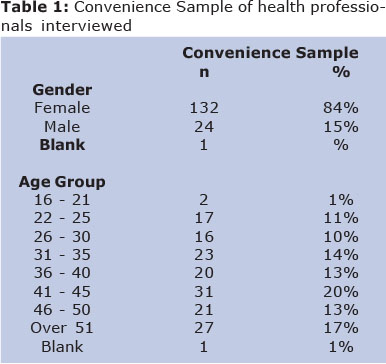
According to the class of age group this research indicates that 51% of the analyzed workers have more than 40 years old. This information uplifts some concern due to the fact that this group (female and over forty years) might have some limitations at the moment of fire fighting with extinguishers of carbon dioxide and water because they may not be prepared to handle the weight due to deficient physical preparation.
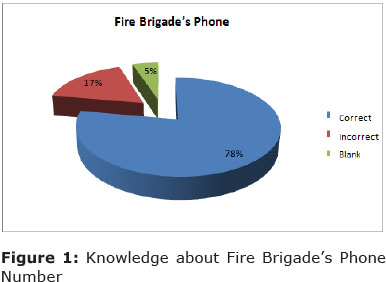
The crucial data of the case study is the unawareness of health professionals relatively to the Fire Brigade's phone number. Throughout the transformation of data several professionals reported that the fire department's number was 192 which consists of the Mobile Emergency Service and they are used to work with healthcare services so they could have been a misun-derstood.
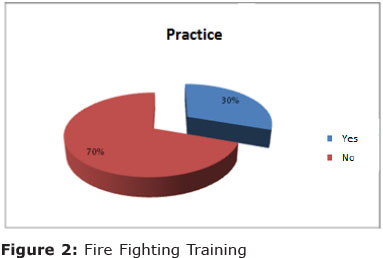
The preponderance of workers has never participated in fire safety training. The sector which takes care of training in health diverges from council to council and it is entitled of continuous education. Habitually the training is focused on health and patient safety.
Due to the low participation at fire safety training around 74% of professionals claim that they do not know how to handle a fire extinguisher, 24% claim to have the knowledge and ability to use them and 2% did not answer. Several professionals reported that they do not know the difference within the fire extinguishers group even noticing that there are different sizes and styles (Figure 3).

Despite the fact that hydrants are not compulsory in the basic health it was examined if health professionals would know to use this equipment in case of fire. Approximately 83% claim that they do not know how to use the equipment, 4% answered that they know how to use the fire hydrant while 3% did not answer (Figure 4).
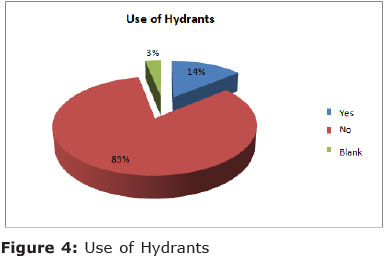
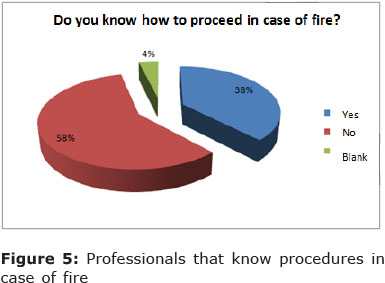
Due to the inexistence of training and not even any recycling about fire safety 58% of employees do not know how to proceed in case of fire; 38% reported that they know how to act in case of fire and 4% haven't had any response.
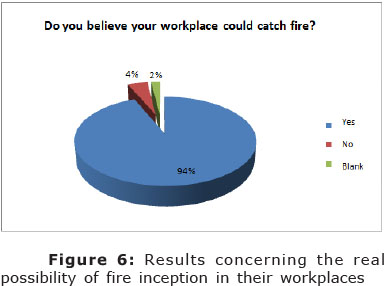
One of the questions verified was if the professional has the belief that his workplace could catch fire. Even though it seems a logical question around 4% believe that their workplace is safe against fire. The majority (94%) said their work unit may catch fire whereas 2% did not answer this question.
Despite the fact that a small percentage does not believe that their health unit can catch fire all of them are unanimous in portraying the importance of firefighting preparation.
DISCUSSION
It is necessary the implantation of norms based on performance in Brazil as a result of a demand created by the attachment to a global economy and a search for the optimization of the self-benefit relation. Therefore the results suggest a gradual implementation in a long term with a simultaneous interaction between prescriptive norms and standards based on performance in order to minimize eventual damages not only to human lives but also to the environment and patrimony for a certain level of safety4.
Beyler claims that the ultimate challenge of fire safety in the twenty-first century will be the cost reduction. He emphasizes that in Brazil in the recent decades there has been an awareness upraise related to the low investment regarding minimum acceptable levels of fire safety in buildings8.
Security measures can be assumed in the forms of active and passive protection. The regulated measures have purposes like have the objective of limiting the mass fuels; restrain the combustibility of materials, rapid evacuation and ensuring sufficient stability to allow the evacuation of occupants and firefighting the threat5. A wide training from the design professionals and supervisory authorities are part of the solution to achieve the reality of a high level of fire prevention.
The results have exposed nerve-racking results regarding the level of preparation in Basic Health Units. The professional's must have all the tools to safeguard human lives' as well as material goods in these facilities. Beside the fact that the Basic Health Units offer to professionals all the utensils necessary in prevention and fire extinguishing the data revealed that a knowledge and practice is not verified within health professionals.
The Decreto Estadual 56.819/11 as he addresses to the basic health units, advocates that the BHU should have to carry fire extinguishers to fight the start of a fire, signaling the evacuation routes, information about the existence of combat equipment through pictograms and emergency exits unobstructed in order to the flee of the population in the unfortunate event, however, the pedagogical issues are not ready to implement6.
There is huge diversity of professionals' positions in a Basic Health Unit which implies a herculean effort in coordination about the level of formation and practice provided to all professionals5,9.
As it can be remarked by observing results there are 117 professionals (74%) that don't have knowledge of using a fire extinguisher. Subjoin this fact 92 professionals (58%) do not know how to proceed in case of fire which reveals a severe precedent in the organization of the Brazilian Health System (SUS). It reveals that more than half of the total amount of professionals would not have clairvoyance to guide in case of sinister.
In case of sinister and because it is a health unit, there are many patients who wander and they are mostly elderly and children and it means that the best group to act in case of fire would be professionals who know the layout of the health unit and where firefighting equipment is and escape routes as well.
The study reveals that 110 (70%) professionals have never participated in training which infers that even though they know the premises they could not be able to identify and put into practice evacuation measures in order to defend material goods and human lives.
The existence of equipment's to fire extinguish must be related to a practical knowledge and it should be applied for the existence of a training of fire brigade which is inaccurately not predicted in the decreto estadual.
Research shows that despite the fact that all employees surveyed believe in the importance of training in firefighting basic health units everyone as soon as they are confronted with legislation it is recognized that it should be different. Professionals refer that their units are predisposed to fire but few have enough knowledge about procedures to have at the time of adversity. Individuals who claim to have instructions of operating in these moments were oriented in previous companies.
The low amount of knowledge of professionals of these units about fire prevention and fire charge in BHU in some divisions are critical points for safeguard and protect human lives
It stands out a limitation in this study because health professionals may have transmitted the information about the fulfilling of the questionnaires that could have passed the information to other coworkers which may have caused a bias in the results.
Finally, as we have seen, health is often defined as a result of complex interactions. More than two decades ago, Maurice King reminded us that 'Health is a Sustainable State'10, that is something constantly on the move and depending on constant attention, active maintenance and care. In particular, that the achievement of a good quality of public health depends on our ability to make the right choices regarding the environment that determines the current health status of a population, but also to make the right choices and take the appropriate actions to prevent foreseeable threats. How we define the quality of public health at any given time must be compatible with future generations enjoying health define in an equivalent way. Public health practitioners must also integrate sustainability in the definition of public health11,12.
According to the results obtained, it can be assumed that in general health professionals still have some limitations regarding the thematic of fire and procedures to avoid it. It is fundamental that these matter continues to be an area of investment so that the professional's procedures and consequently the safety and health of patients and professional's. Therefore with this awareness a safe attitude may be implemented without endangering their own life and minimize patrimonial damage and safeguarding human lives.
DISCUSSION
It is necessary the implantation of norms based on performance in Brazil as a result of a demand created by the attachment to a global economy and a search for the optimization of the self-benefit relation. Therefore the results suggest a gradual implementation in a long term with a simultaneous interaction between prescriptive norms and standards based on performance in order to minimize eventual damages not only to human lives but also to the environment and patrimony for a certain level of safety4.
Beyler claims that the ultimate challenge of fire safety in the twenty-first century will be the cost reduction. He emphasizes that in Brazil in the recent decades there has been an awareness upraise related to the low investment regarding minimum acceptable levels of fire safety in buildings8.
Security measures can be assumed in the forms of active and passive protection. The regulated measures have purposes like have the objective of limiting the mass fuels; restrain the combustibility of materials, rapid evacuation and ensuring sufficient stability to allow the evacuation of occupants and firefighting the threat5. A wide training from the design professionals and supervisory authorities are part of the solution to achieve the reality of a high level of fire prevention.
The results have exposed nerve-racking results regarding the level of preparation in Basic Health Units. The professional's must have all the tools to safeguard human lives' as well as material goods in these facilities. Beside the fact that the Basic Health Units offer to professionals all the utensils necessary in prevention and fire extinguishing the data revealed that a knowledge and practice is not verified within health professionals.
The Decreto Estadual 56.819/11 as he addresses to the basic health units, advocates that the BHU should have to carry fire extinguishers to fight the start of a fire, signaling the evacuation routes, information about the existence of combat equipment through pictograms and emergency exits unobstructed in order to the flee of the population in the unfortunate event, however, the pedagogical issues are not ready to implement6.
There is huge diversity of professionals' positions in a Basic Health Unit which implies a herculean effort in coordination about the level of formation and practice provided to all professionals5,9.
As it can be remarked by observing results there are 117 professionals (74%) that don't have knowledge of using a fire extinguisher. Subjoin this fact 92 professionals (58%) do not know how to proceed in case of fire which reveals a severe precedent in the organization of the Brazilian Health System (SUS). It reveals that more than half of the total amount of professionals would not have clairvoyance to guide in case of sinister.
In case of sinister and because it is a health unit, there are many patients who wander and they are mostly elderly and children and it means that the best group to act in case of fire would be professionals who know the layout of the health unit and where firefighting equipment is and escape routes as well.
The study reveals that 110 (70%) professionals have never participated in training which infers that even though they know the premises they could not be able to identify and put into practice evacuation measures in order to defend material goods and human lives.
The existence of equipment's to fire extinguish must be related to a practical knowledge and it should be applied for the existence of a training of fire brigade which is inaccurately not predicted in the decreto estadual.
Research shows that despite the fact that all employees surveyed believe in the importance of training in firefighting basic health units everyone as soon as they are confronted with legislation it is recognized that it should be different. Professionals refer that their units are predisposed to fire but few have enough knowledge about procedures to have at the time of adversity. Individuals who claim to have instructions of operating in these moments were oriented in previous companies.
The low amount of knowledge of professionals of these units about fire prevention and fire charge in BHU in some divisions are critical points for safeguard and protect human lives
It stands out a limitation in this study because health professionals may have transmitted the information about the fulfilling of the questionnaires that could have passed the information to other coworkers which may have caused a bias in the results.
Finally, as we have seen, health is often defined as a result of complex interactions. More than two decades ago, Maurice King reminded us that 'Health is a Sustainable State'10, that is something constantly on the move and depending on constant attention, active maintenance and care. In particular, that the achievement of a good quality of public health depends on our ability to make the right choices regarding the environment that determines the current health status of a population, but also to make the right choices and take the appropriate actions to prevent foreseeable threats. How we define the quality of public health at any given time must be compatible with future generations enjoying health define in an equivalent way. Public health practitioners must also integrate sustainability in the definition of public health11,12.
According to the results obtained, it can be assumed that in general health professionals still have some limitations regarding the thematic of fire and procedures to avoid it. It is fundamental that these matter continues to be an area of investment so that the professional's procedures and consequently the safety and health of patients and professional's. Therefore with this awareness a safe attitude may be implemented without endangering their own life and minimize patrimonial damage and safeguarding human lives.
REFERENCES
1. DL 426/89 - Medidas Cautelares de Segurança contra Risco de Incêndio em Centros Urbanos Antigos Ministério da Administração Interna e das Obras Públicas, Transportes e Comunicações. Diário da República, 1.ª série, Decreto Lei n.º426 de 6 de Dezembro de 1989. Lisboa. pp:5309-5313. [ Links ]
2. Grupo de Fomento à Segurança contra Incêndios (GSI), A Tragédia em Santa Maria e as questões sobre segurança contra incêndios no Brasil; São Paulo, 2013 [ Links ]
3. Portal Brasil, Disponível em http://www.brasil.gov.br/saude/2011/09/usuarios-do-sus-serao-atendidos-em-unidades-proximas-a-seus-domicilios. Fontes: Ministério da Saúde, Relatórios de UBS, Departamento de Atenção Básica, Sistema único de Saúde, Setembro 2013 [ Links ]
4. Claret AM, Mattedi DL. Estudo da prescritividade das normas técnicas brasileiras de segurança contra incêndio. R. Esc. Minas 2011; 64(3): 265-271. [ Links ]
5. SEITO, Alexandre Itiu. et al. A segurança contra incêndio no Brasil. São Paulo: Projeto Editora, 2008. [ Links ]
6. Decreto Estadual nº 56.819/11. Regulamento de segurança contra incêndio das edificações e áreas de risco. Polícia Militar do Estado de São Paulo. Corpo de Bombeiros. Decreto Estadual nº 56.819/11. São Paulo. 2011. [ Links ]
7. Reis RJ, La Roccaa PF, Silveira AM, Bonilla IML, Ginéc AN, Martín M. Fatores relacionados ao absenteísmo por doença em profissionais de enfermagem. Rev Saúde Pública 2003;37(5):616-23. [ Links ]
8. Beyler CL. Fire Safety Challenges in the 21st century. Journal of Fire Protection Engineering 2001; 11(1): 4-15. [ Links ]
9. Fernandes R. Regulação na Proteção e Socorro: Segurança contra Incêndios em Edifícios. Dissertação de Mestrado, Lisboa, 2009. [ Links ]
10. King, M. Health is a sustainable state. Lancet, 1990, 336: 664-667. [ Links ]
11. McMichael, AJ. Population health as the 'bottom line' of sustainability: a contemporary challenge for public health researchers. European Journal of Public Health, 16: 579-582. [ Links ]
12. Atrash HK, Carpentier R. The evolving role of public health in the delivery of health care. Journal of Human Growth and Development. 2012; 22(3): 396-399. [ Links ]
Manuscript submitted Aug 01 2013
Accepted for publication Dec 28 2013
Corresponding author: profferfonseca@gmail.com













